Today we are looking at the ASRock Rack X570D4U-2L2T. This board is a direct successor to the X470D4U and X470D4U2-2T that we previously covered, and maintains a mATX form factor, unlike the X570D4I-2T. When we covered the X470 boards, they presented an interesting concept that was somewhat roughly executed; with today’s review, we will see if ASRock Rack’s second-generation product has managed to deliver a more polished product than those first-gen efforts.
ASRock Rack X570D4U-2L2T Overview
The ASRock Rack X570D4U-2L2T is a mATX motherboard measuring 9.6” x 9.6”. In that form factor, you get the AM4 socket which, at the time of our testing, accepts Ryzen 3000 series CPUs and Renoir 4000 series APUs.
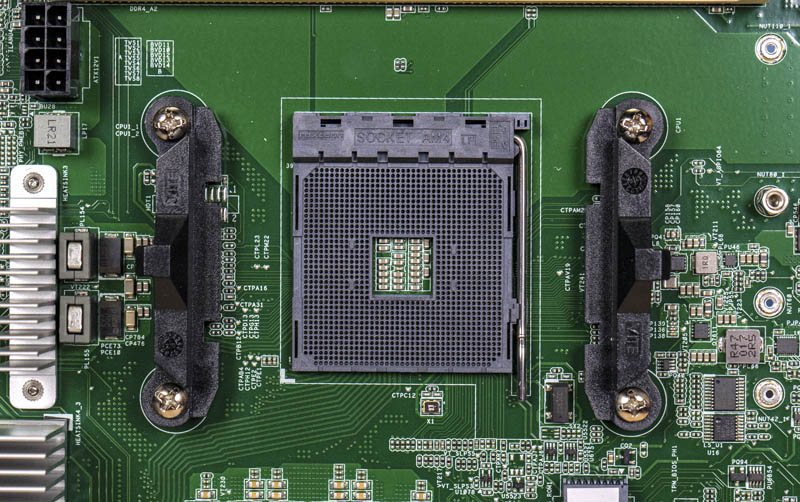
The Ryzen CPUs provide dual-channel memory support, and the board has four slots accepting unbuffered ECC DDR4 at speeds up to DDR4-2933. Compared to the mITX X570D4I-2T, the 4 full-sized DIMM slots are a much more normal configuration.
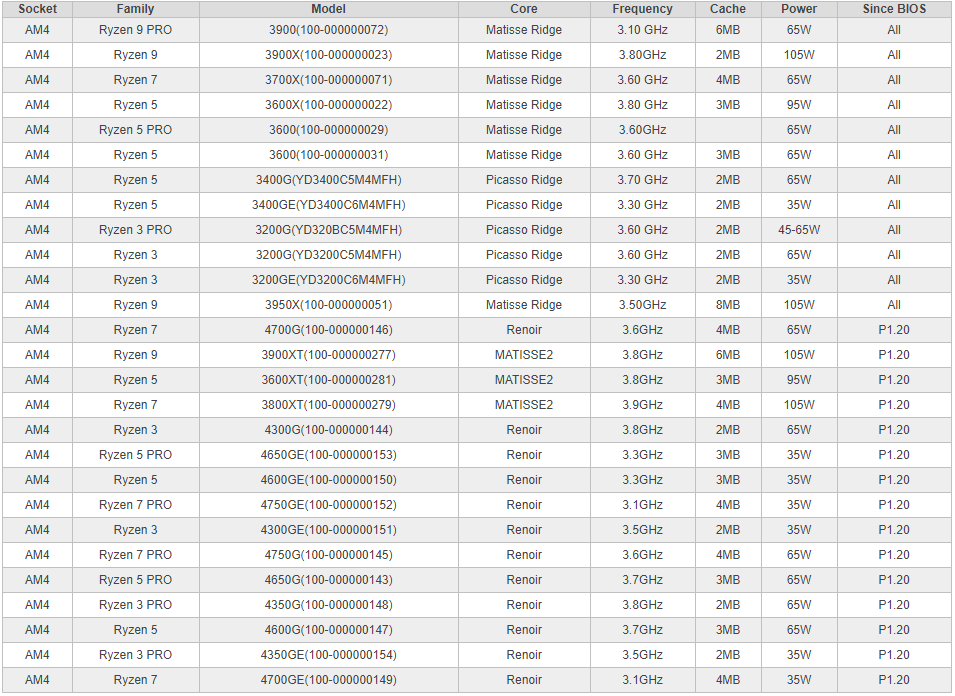
The X570D4U-2L2T is built upon the AMD Socket AM4 platform and features the X570 chipset. Normally AM4 sockets support a wide range of CPUs available at different core counts, but this board is a bit different. The X570D4U-2L2T has a very limited list of CPUs on its official support list; thus far only the original Ryzen 3000 SKUs are supported, ranging from the 4-core APUs to the 16-core Ryzen 9 3950X. Noted as absent are the 4-core 3100 and 3300X chips, though the newer XT chips and Renoir 4000 series CPUs are now officially supported. Excluded from this list are any of the 1000 or 2000 series Ryzen CPUs, and I attempted to test a Ryzen 7 2700 and it did not boot.
Looking to the future, the X570 chipset has received support from AMD’s Ryzen 5000 series CPUs based on Zen 3, though as of when we tested this motherboard an updated BIOS incorporating that support has not yet been released. When that BIOS update is released, we will update this article.
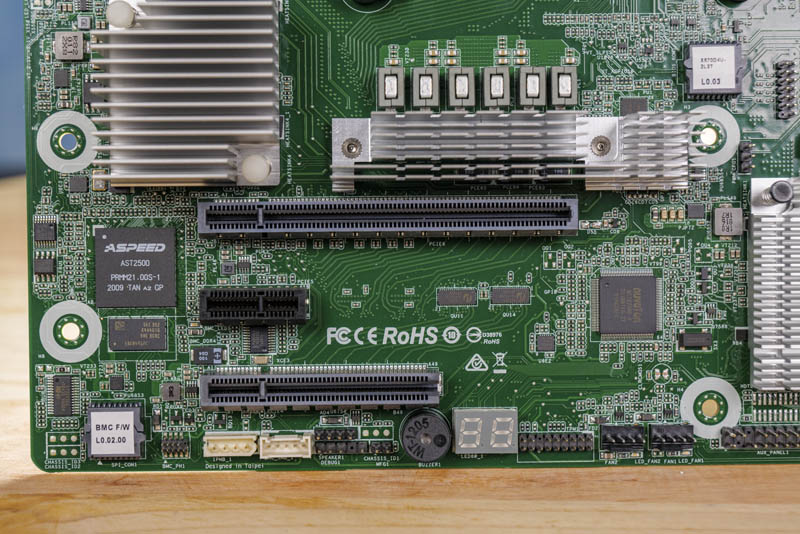
Thanks to the upgrade to the X570 chipset, this motherboard is capable of PCIe Gen4 speeds. With the larger mATX form factor, connectivity is much expanded compared to the mITX board. The x16 slot, x8 slot, and one of the two M.2 slots are all directly connected to the CPU PCIe 4.0 lanes, and the X16 slot supports bifurcation as well. The chipset is then connected with an x4 PCIe 4.0 link, and from there the chipset serves up the second M.2 slot, the x1 PCIe slot, and the PCIe lanes used by the networking controllers. This does mean that the chipset PCIe 4.0 link is oversubscribed, potentially by a large amount if all of the chipset-connected devices are simultaneously utilized. PCIe connectivity is one of the major areas that the X570D4U series massively improves over the previous X470D4U boards, especially for users that care about M.2 NVMe speeds.
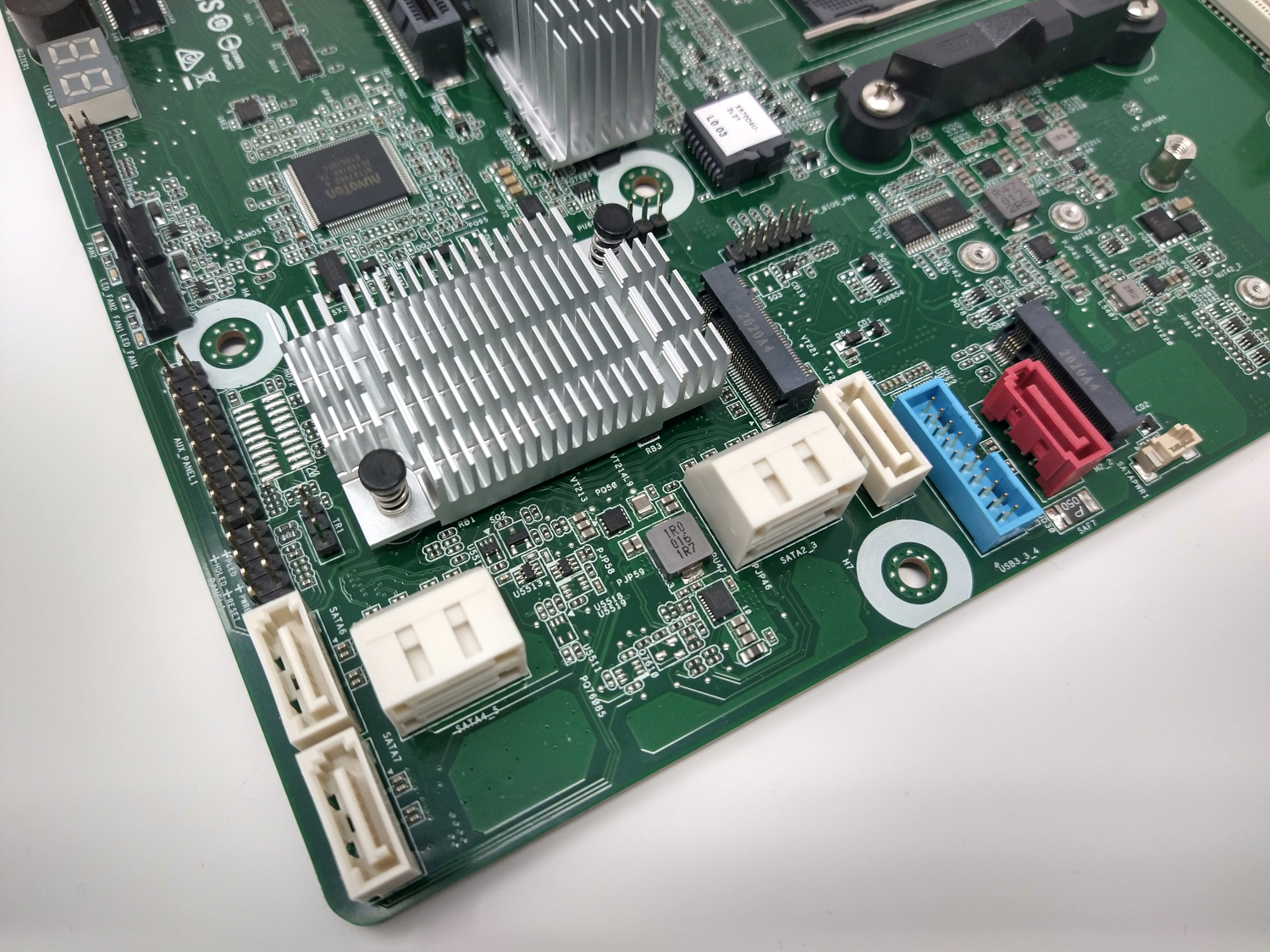
Plentiful SATA storage connectivity is present, with eight slots directly provided on the board and four more slots available through the use of an M.2 adapter. One of the onboard ports also supports powering a SATA DOM.
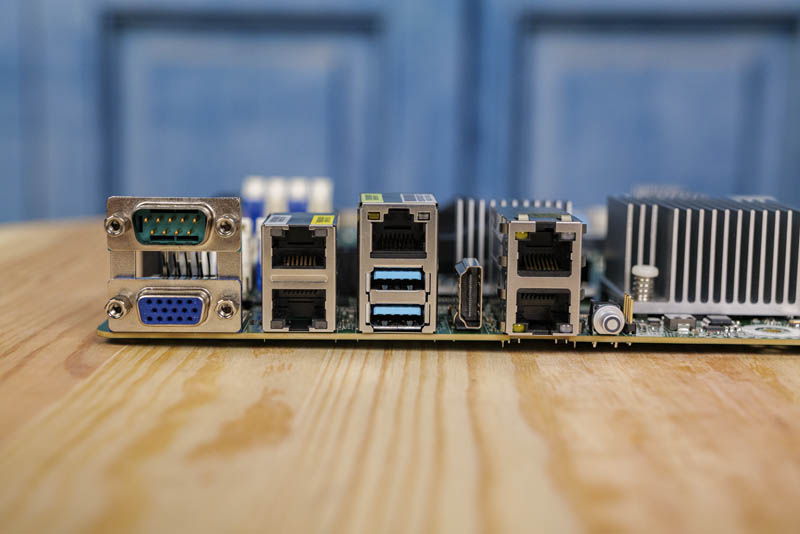
Rear I/O is a bit better than the X470 boards that came before, but not much. There are only two USB 3.0 ports and a serial port. The VGA output and dedicated NIC for the ASPEED AST2500 are both still present, and still represent the defining feature of this board. In an improvement over both the X570D4I-2T and the previous X470D4U2-2T, the X570D4U-2L2T sports both two 10GbE connections powered by an Intel X550-AT2 controller, while retaining the two 1 GbE connections powered by an i210 controller. Also new is the HDMI output for use by APUs. One note, the shared interface for the AST2500 is on the 10 GbE NIC, not the 1 GbE NIC.
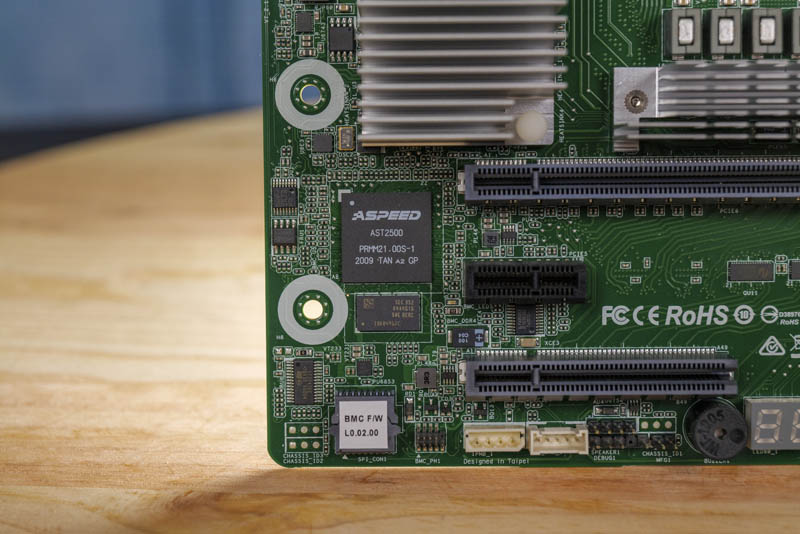
That ASPEED AST2500 is the baseboard management controller and is one of the two defining features of this motherboard, along with the dual 10Gbase-T networking. The BMC allows out of band management of the system, full remote KVM, and mounting of virtual media over the network.
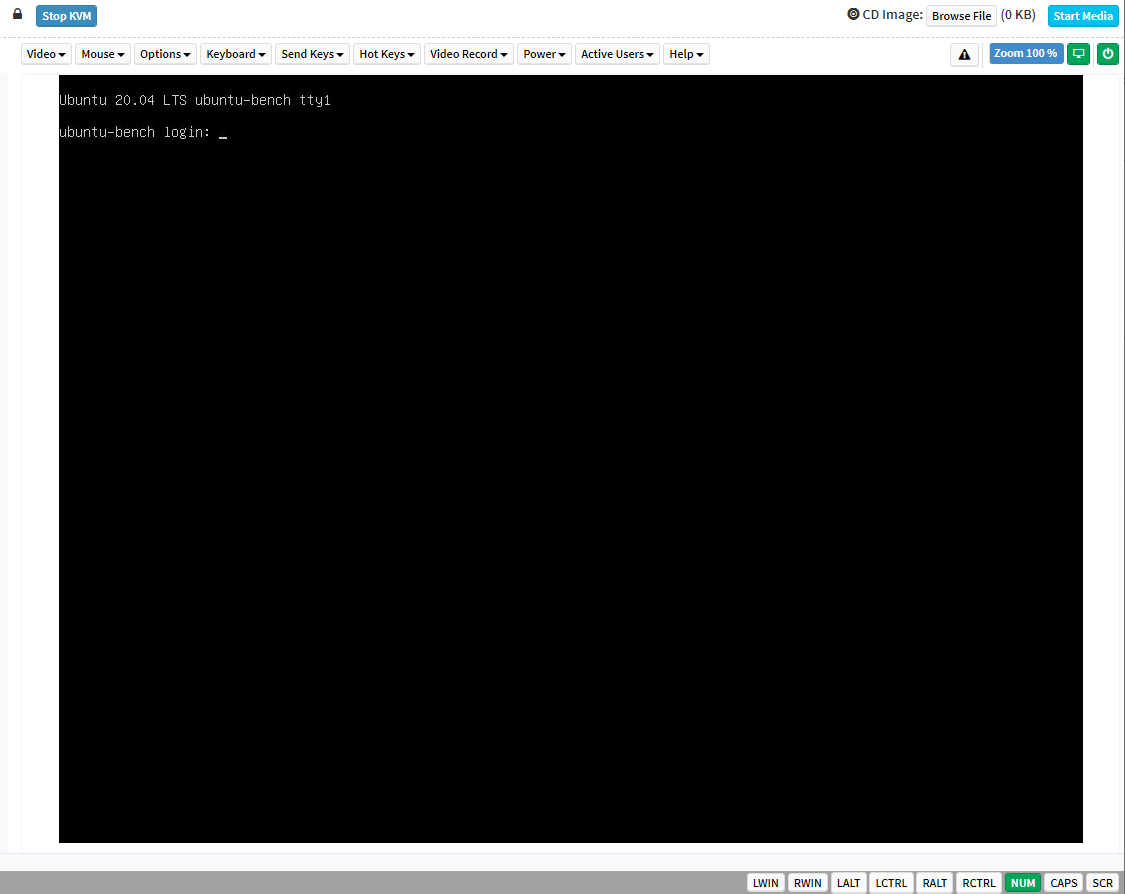
Many of STH’s readers will be familiar with the ASPEED brand of BMC. ASPEED is commonly used on Inspur, Supermicro, Gigabyte, and other vendor boards. We also see them used in hyper-scale servers. An example is when we covered how Facebook Introduces Next-Gen Cooper Lake Intel Xeon Platforms. Its inclusion on a Ryzen board is very nearly unique at this point in time. If you need IPMI support from a Ryzen-based platform to be able to deploy and manage the server remotely, the offerings from ASRock Rack are essentially the only options around.
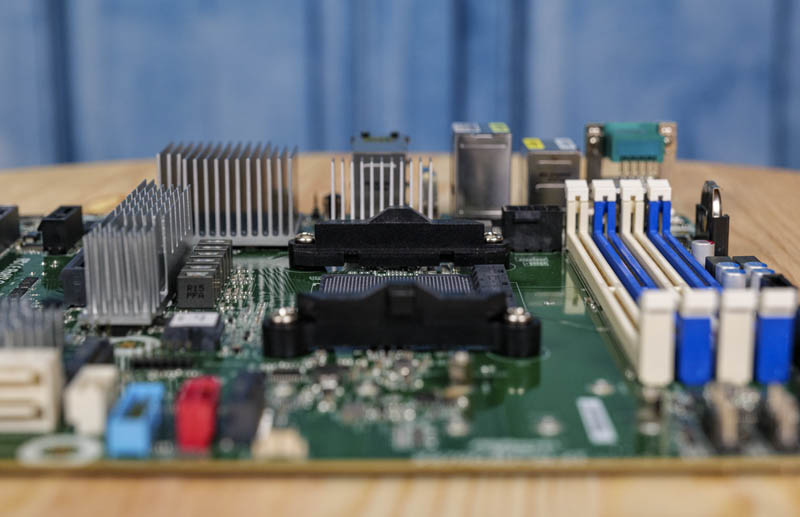
The system itself is set up for front to rear airflow as we would see in most server chassis. The X570, X550-T2, and VRM heatsinks are all oriented in this fashion, as are other components. When you construct a system around this platform, be mindful of airflow.
ASRock Rack X570D4U-2L2T Design Refinements
Avid STH readers may remember that in our review of the mITX X570D4I-2T, a lengthy section of the article was dedicated to all of the complexity of cooling that board. Additionally, readers with even longer memories will remember that the X470 boards had some memory slot clearance problems with certain coolers like the stock Ryzen 3600 cooler. Well, I am happy to report that no such troubles exist on the X570D4U-2L2T. Stock AMD coolers fit with ample clearance on this new board, and the socket does not have any of the Intel-style retention mechanism “uniqueness” that the mITX motherboard had. The only remaining cooling concern for this board compared to any other desktop-class X570 board is that the chipset is still passively cooled, where almost all X570 chipsets are actively cooled. As part of my testing, I once again verified that without airflow over the chipset heatsink, the system is unstable under load. A simple low-RPM 80mm fan pointed in the general direction of the chipset heatsink easily remedied this problem, but it is still a design consideration that end users will need to be aware of.
ASRock Rack X570D4U-2L2T Topology
We wanted to take a quick moment here to show the system topology. We described it in words above but seeing it helps. First, here is the block diagram:
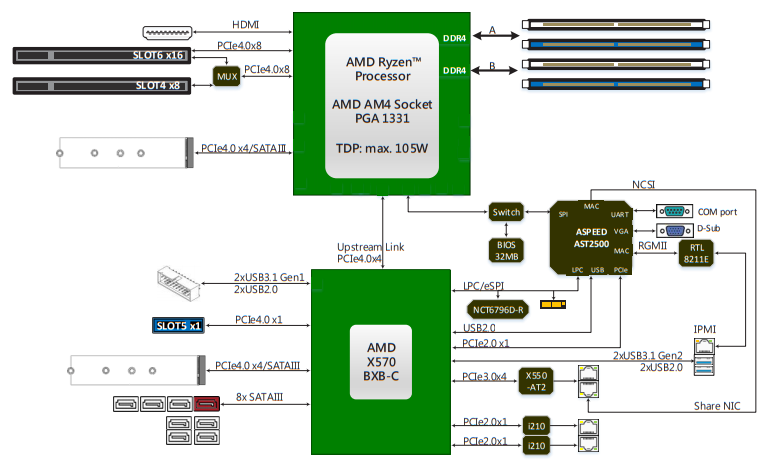
One can clearly see the potential bandwidth contention problem caused by the single PCIe 4.0 x4 uplink between the X570 chipset and the CPU, since that same chipset provides multiple PCIe 4.0 and 3.0 links on its own to various devices, along with SATA and USB connectivity. Next up is the system topology:
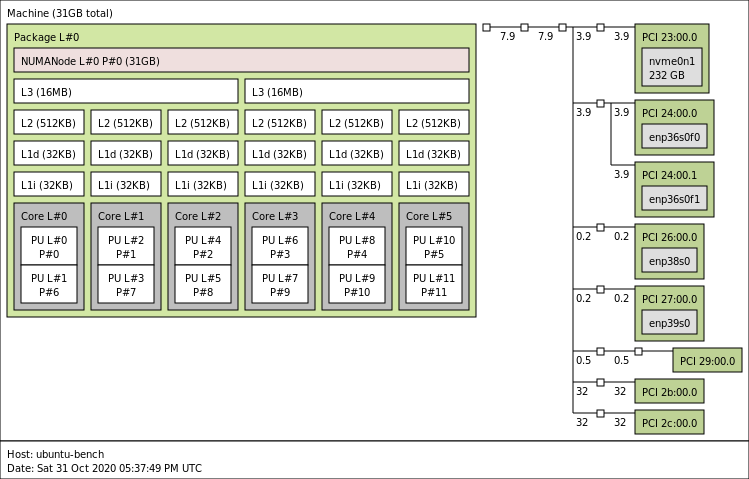
Since this is based on Ryzen, it is a single NUMA node design. AMD EPYC 7001 8-core servers, such as those based on the AMD EPYC 7251 had four NUMA nodes which created a lot of inter-die traffic. With Ryzen, one does not have to worry about that on these lower-cost platforms.
Next, we are going to look at the CPU options, management, test configuration, and OS testing, before getting to performance and power consumption.

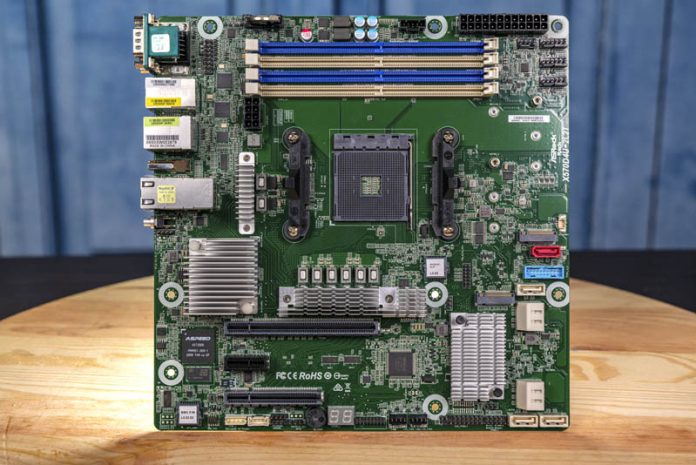



“One note, the shared interface for the AST2500 is on the 10 GbE NIC, not the 1 GbE NIC.”
A word of warning that if you accidentally enable IPMI access to the 10 GbE NIC (eg. selecting link aggregation in the IPMI settings), it will wreak havoc with performance on that interface.
I spent weeks trying pfSense tuning settings to figure out why performance was nowhere near 10 Gbps. It was only by accident that I noticed the IPMI setting and turned it off.
Great review and certainly a compelling alternative to something like the SM X11SCH-LN4F.
I asked Asrockrack about supporting DDR4 ECC RDIMMS, they are not supported.
Bad luck, and it is sad.
Any comment on the lack of ECC report support?
Will it still be able to correct smaller bit errors, don’t even know if ECC is capable of that?
In my +25 year in the IT business I cannot remember I have ever ran into a computer that had corrupted modules in a way where ECC would have seemed to make any difference. As fare I can remember it has always been a matter of boot errors or the computer couldn’t see the module at all. Not saying it couldn’t be the case, but I can’t remember I’ve ran into the situation myself.
@MrCal: ECC-Errors goes along with me since dekades with different vendors.
@Willy: These guys measures different Power consumption: https://www.hardwareluxx.de/index.php/artikel/hardware/mainboards/53917-asrock-rack-x570d4u-2l2t-im-test-fuer-den-home-server-bereich.html?start=5
How well your measurement device works with complicated power factor conditions?
Did you have a look at the iommu grouping of that board?
Anyone has distributor in EU that could offer combo with chassis for this baby? If they can do QA before shiiping, I’m all in.
Tnx
“One note, the shared interface for the AST2500 is on the 10 GbE NIC, not the 1 GbE NIC.”
Any particular reason why they did so ? 1 GbE was not enough for IPMI ?
domih,
I assume it was so that, under the assumption you only had a single available switch port to plug the server in with, that you could have both 10 GbE and IPMI access.
The lack of ECC error reporting is kind of unfortunate.
@Datasaver Someone posted IOMMU groupings for the X470D4U board a couple months ago, which I assume would mostly translate to the X570D4U, too: https://www.reddit.com/r/ASRock/comments/hwuotz/asrock_rack_releases_microatx_x570d4u2l2t_based/g3pp023/?utm_source=reddit&utm_medium=web2x&context=3
@Datasaver/@Will Taillac:
Both my Xeon D-15xx Boards draw more Power than servethehome has measured. I always wondered what I am doing wrong in configuring the systems, as power consumption is important for me.
My X10SDV-TP8F idles at 26W with everything stripped except for 2*32GB RAM, a single mSATA-SSD and a small FAN at low revs. I use a 300W Gold PSU. “Power off/BMC only” is 7.5W in this configuration. Servethehome has measured 22.9W/4.9W for the X10SDV-4C+-TP4F in a test configuration with double the RAM and many SSDs. If I move closer to the test configuration used for the review of the board, I am at >30W/10W.
I wonder where the difference comes from, especially since even if I assume that servethehome is measuring power with a simple configuration, at least my BMC only values are to high. One can argue that my board has an additional quad port i350 NIC, but even the X10SDV-7TP8F was measured at only 5.0W and it has my configuration +12 Cores +SAS-HBA
@cspguy: RDIMMs are not supported on Ryzen or Threadripper, you have to go to EPYC to get RDIMM support. There’s nothing ASRock Rack can do about this, it’s a limitation from AMD.
This board will do 3200M/T memory, as long as its only two sticks, according to Asrock. 4 sticks is 2933 if single rank, 2667 if dual rank (if i read their response correctly). They also confirmed that Ryzen 5000 support is coming sometime December or January.
How would this board do in a workstation? I’ve been trying to make a compact desktop for work and gaming with 10gbe, but available components are sparse. Next best solution is some finagling with a pcie extender to make room for the chunky gpu.
Hello,
Does the motherboard includes an integrated, non-removable, backplate on the socket as the X570-D4I-2T ?
Thanks !
@Elsa,
Yes. But it’s a standard AM4 backplate design, nothing Intel flavored like on the X570D4I-2T. The stock Ryzen 3600 cooler mounts just fine (wraith spire), as does the Wraith Prism.
@Patrick,
As a workstation board, this will do fine, though perhaps not better than any other X570 board. The BMC doesn’t do much for a workstation. On the other hand, it may actually be the least expensive X570 board with onboard 10 GbE networking, but you can always just get a ‘normal’ X570 board and an add-on PCIe 10 GbE NIC.
What i really hate, also on the X399D8A, is that anoying slow media speed via BMC. Why, Asrock??? It’s almost impossible to use that for a reasonable remote installation e.g. of anything larger than a MSDOS image. Installing Windows or also TrueNAS/FreeBSD is a pain.
Why the heck? My old X10SL7-F and X11SSH-CTF (both having the older AST2400) are also not fast, but much more bearable.
And also, routing the BMC via 10GB at the X11SSH-CTF does not reduce 10G speed in my case.
So, allthough i really would like to use the Ryzen Zen2 or 3 as a multipurpose home server, the Asrock Rack AMe/TR4 boards try to mimic server boards and present lots of server features, but are lacking in the end a good implementation.
– only partial ECC features (even my B550M Tuf Gaming reports ECC to the OS)
– almost impossible BMC media useage
– slow memory speeds with 4 sticks (and we all know: memory speed is important for Ryzen)
– it seems performance problems when routing BMC over the regular NICs
– only limited attention for Bios updates.
So, all in all, the plattform looks attractive at the first glance, but seems to lack enthusiasm in the details then leaving it with some quirks.
@ZFSfan
My understanding of the “ECC reporting” problem is that the OS will be aware of an ECC event, but the report does not travel ‘upstream’ to the BMC/IPMI environment, where it normally would on a normal ‘server-class’ platform. Since the BMC is where many sysadmins make their first stop when investigating a potential hardware issue, lack of memory reporting in the BMC log is a big deal.
Windows Server 2016 and 2019 dont work on this board. Warning.
@AW,
I cannot speak to Windows Server 2016 since I did not personally test it. However, I have encountered no difficulties with Windows Server 2019, as you can see here: https://www.servethehome.com/wp-content/uploads/2020/11/ASRock-Rack-X570D4U-2L2T-Windows-2019.png
Windows Server 2019 works fine, I installed it earlier today on my X570D4U-2L2T along with an AMD Ryzen 5950X using the beta BIOS.
Currently in the process of building 3 servers build around this motherboard for those interested (first completed as of today) – https://forums.servethehome.com/index.php?threads/asrock-x570d4u-2l2t-build.30697/
Just in stock at Newegg, I snatched one
Does anybody know it it allows iGPU passthrough for a 4xxx series APU?
Despite the reported slow virtual Media speed and my small “rant”: I got that board and paired it with a 5600X and 4*16GB ECC-Ram (Samsung B-Die modules).
And, I’m happy with it and can support the high rating now. I tested it with Server 2016, 2019 (no left device manager items without driver), ESXI 7.0 and Win10. Works like a charm incl. some moderate memory OC.
Windows, Memtest and FreeBSD are showing “ECC”, so the corrective function seems to work.
Also Passthrough of a SAS-HBA (9400-16i) from ESXI to a FreeBSD-VM (for ZFS) works.
To be on safe side, i gifted the X570 chipset a silent 60mm fan blowing in direction of the two M.2 sockets to bring a little airflow also to the NVME drives. Without a little airflow, i got very soon a overtemp warning from the IPMI for the X570.
All in all: nice little board to squeze out all of the PCIe lane possibilities of AM4 plattform, high clocked CPU cores, surprisingly (for X570 and non-APU processor) pretty energy efficient.
Has anyone installed ESXi latest release with SATA passthrough? it will allow to enable it but it won’t work
1609631249295.png
It stays on the Need Reboot option and won’t show it to the VM
Maybe because this board is not officially supported? I am going to have to get an HBA for it which I was trying to avoid
ZFSfan your board is running at 2933 with the 4 modules correct? could you list where you got it? thanks
What the chipset running very hot? The heatsink is kind of small. Someone did report 81 C at idle.
Could someone enlighten me if I would be running out of PCIe lanes with this build? Many thanks!
CPU: 5950x
GPU: 3060ti – PCIe 4.0 x8 (limited from x16 to x8 because of the HBA.)
HBA: LSI 2907 – PCIe 3.0 x8 to backplan
M.2 Slot 1 – Samsung 980 2tb NVME – PCIe 4.0 x4
2x 10Gbe ports – PCIe 3.0 x4
1x Gbit IPMI (I don’t think I understand how this impacts the 10Gbe controller!)
1.) …Do I have any PCIe lanes left?
2.) What are the options if I wanted to expand SSD capacity down the road?
2a.) What would happen if I put another NVME drive in the second M.2 slot?
2b.) Would my only option be to use the SATA ports for SATAIII SSDs?
3.) A 3060ti should have little to no performance loss being 4.0 x8 right? My understanding is that is essentially the same as PCIe 3.0 x16 as far as bandwidth goes.
@Kyle
Personally my worry is that chipset running hot. I saw a video of someone reviewing this board and he went through the sensor pages in the bios and noticed the X570 chipset sensor reporting 81 C !! Now I don’t know if that was a sensor glitch but it did seem very odd. I don’t know if anyone else noticed something similar?
To answer some of your questions :
1) I think you are good as long as you don’t use the second M.2 which apparently shares bandwidth with the NICs.
2) Well you have so many options there, you could buy an internal hotswap drive bay. You could purchase a large SSD and just transfer your files over.
2a) I answered that on point 1)
2b) You could buy a better LSI card with more connections.
3) I think your good but what do you want to do? Video encoding?
@Patrick
Thanks for the info!
Yes I have definitely read that about the chipset being passively cooled and getting a bit toasty. I’ll have a decent amount of airflow from case fans in a rackmount chassis but I’ll definitely add a dedicated fan for the chipset if needed.
I’ll look into a better LSI HBA option…open to recommendations as I can’t say I am very familiar with their line. That was supposed to read LSI 9207 by the way – sorry for the typo! Or maybe I just use a breakout cable on the second port of that card with SFF-8087 to SATA so I can pass through some SATA SSDs…not sure if there is a way to pass through NVME that way.
Yes the 3060Ti would be for video transcoding mostly. I know most use a P2000 for Plex hardware transcoding but it only has 5GB vram so I don’t really see the value when they cost the same except I wouldn’t have to fiddle with the patch to unlock more than two transcode processes at a time. Open to suggestions though. I don’t upgrade hardware often so I want to make it count!
@Kyle
You could try the LSI 9201-16i if you think you’ll need all of that. It would be much better than using the motherboard’s SATA that is for sure.
Hopefully you wont be getting to many issues with the chipset. IT is for that reason that I am considering the little brother X470D4U2-2T. For what I would be doing, it would be more than enough I think and would not have to worry about the chipset overheating in case a fan is defective and whatnot.
@Patrick
Thanks I’ll look into that one. Yeah I understand about the heat but I think I will roll the dice. The addition of PCIe 4.0 in the x570d4u-2l2t is enough for me to take a chance as it provides some more options with the extra bandwidth.
I have 2 NVMEs and would like to use both for an unraid server. If the 2nd NVME shares bandwidth with the nics, I will need to come up with a better plan.
For now, I am thinking maybe I can just get a SATA to NVME converter and use that as an additional drive. Thoughts?
Also, which bifurcation cable can I use with this? I will purchase one but I just needed to know which one is compatible with this.
I will be putting 4 cards in there.
1. NVidia Quadro p600
2. LSI HBA
3. A quad nic PCIe single-slot controller for dedicated ports for all the VMs I will run inside unraid
4. PCIe NVME card to get good NVME performance (this will only be used if the Sata to NVME solution above is slow
How is the stability of this board for 24/7 use?
Is it ok going o Ryzen 5800x or better going to good old 3700x?
Can be used with Esxi 7?
When installing Server 2019 I’ve found 5 unkown devices and Windows 10 (20H2) I’ve found 4 unknown devices. Google&Trial has shown that I need to install
– AMD chipset drivers (just download from the AMD homepage)
– AMD GPIO drivers
– Asrock AMD PCI drivers
After that, all devices were identified. Unfortunately, I got the last two from driverdownload sites, which I can’t say I can recommend doing…
I also got a Noctua NF-A4x20 PWM fan blowing at the X570 chipset to stop it getting super hot like some are reporting. Throttled to the lowest the mainboard fan management and Noctua’s low noise adapter combined can manage (around 1600rpm) the chipset stays cool and the fan is nearly inaudible, even by my ‘annoyed by the slightest noise’ standards.
I see that bifurcation is supported on the PCIe x16 slot but to what level? Can I get x4 x4 x4 x4 out of it?
does this motherboard support AMD Ryzen Pro 5750GE ?